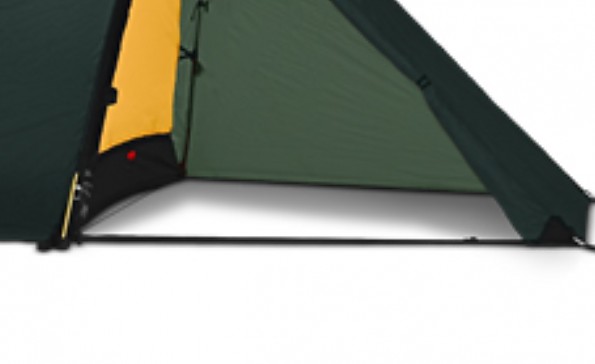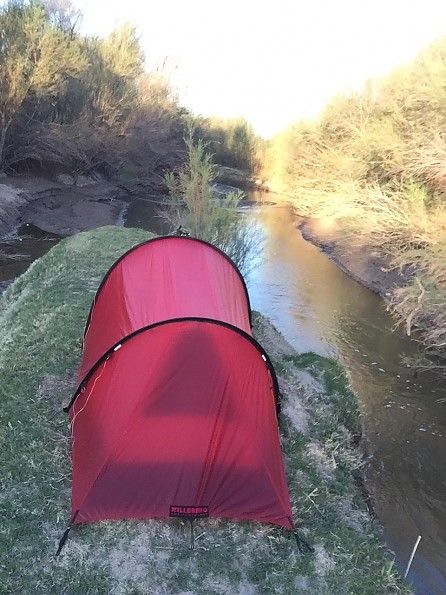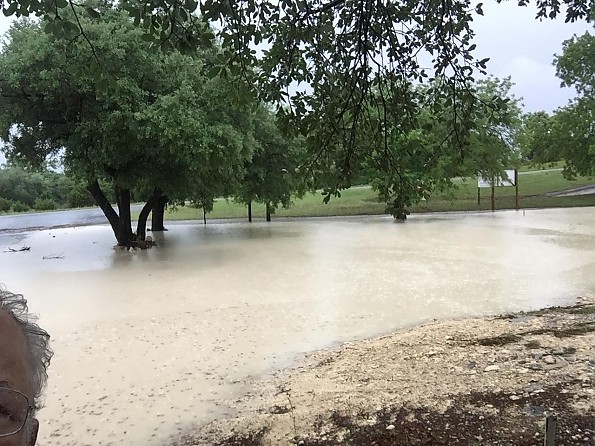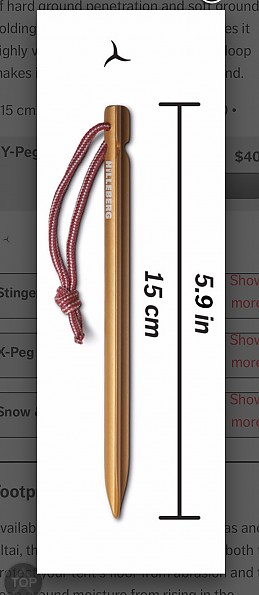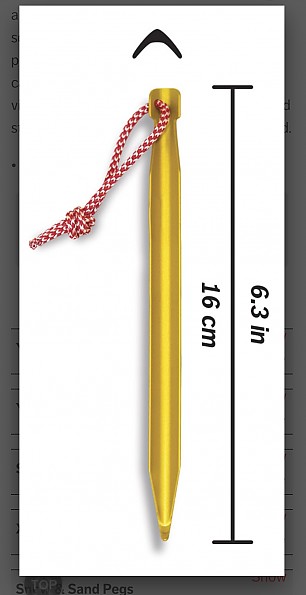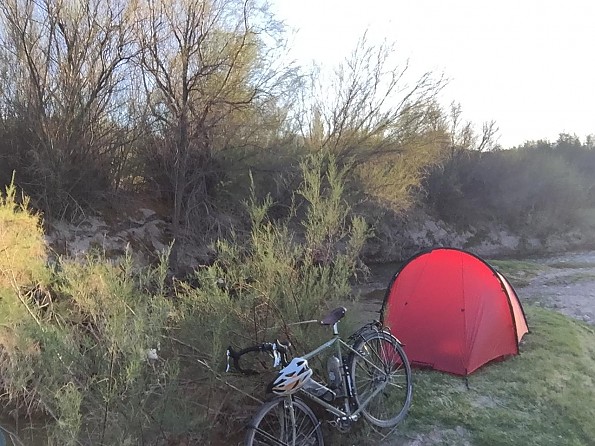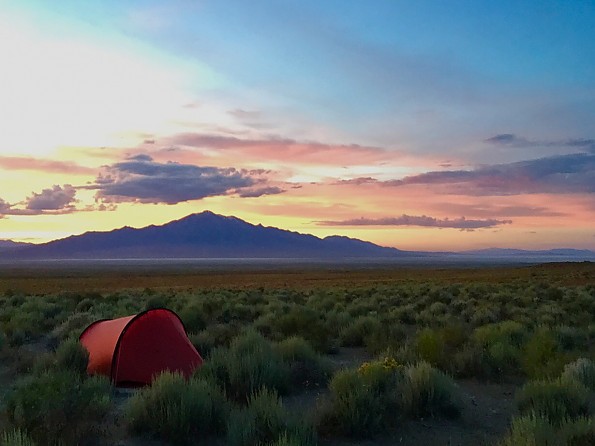Hilleberg Anjan 2
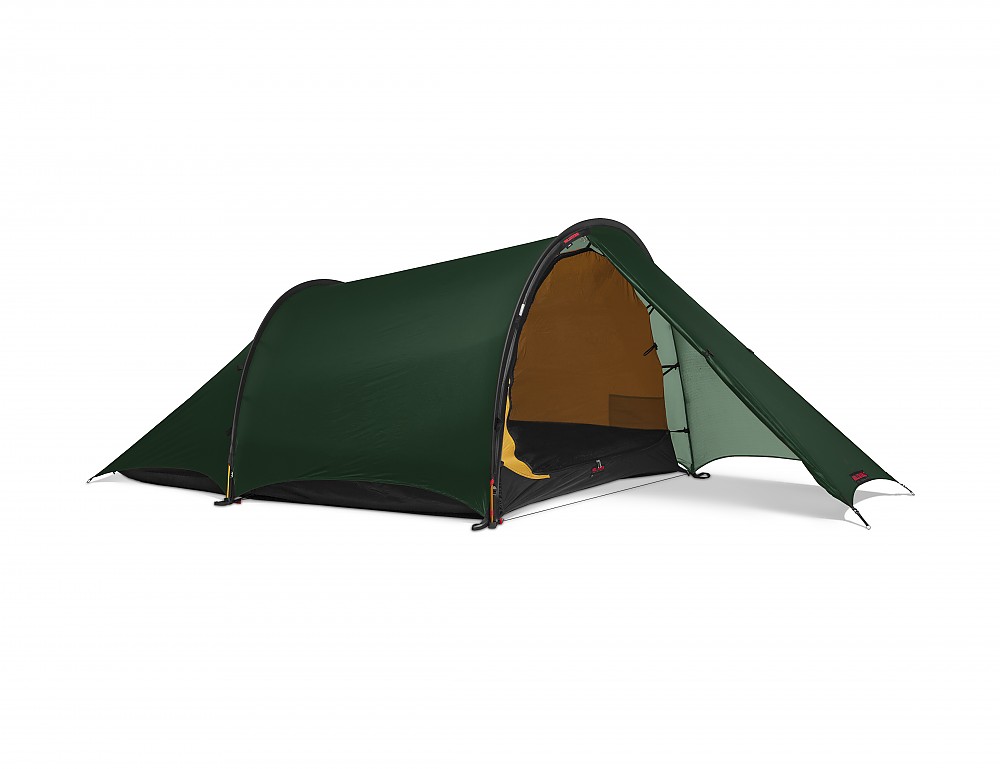
TENT DESIGN UPDATED IN 2017 Tough weather protection for a three-season tent.
Pros
- Lightweight and unbelievable durability
- Excellent fit
- Good ventilation
- Updated outer tent design keeps rain at bay
- Hilleberg’s superior customer service makes for peace of mind
Cons
- Lack of nylon webbing on vestibule door makes for inadvertent over tensioning of zipper
I ordered and received my Hilleberg Anjan 2 in early 2018, to complete the last half of my bicycle tour from Phoenix back to Wisconsin. The tent was redesigned in 2017 I believe, to address the rain protection issues that were described in the previous review. The corners of the outer tent now extend to the ground, while still offering ventilation all the way round via catenary design.
I ordered the tent to give my Hilleberg Soulo a rest for the return leg because of the lighter weight (4 lbs total with pegs) and because of the increased ventilation for use in the warming season ahead. The Anjan is very flexible in this regard, with the all mesh door and mesh panel in the rear which can be accessed by rolling up the rear of the outer tent.
I found the fit of the tent to be exceptional (as you can see by the photographs). Tight as a drum! The stitching was not quite as perfect as that on my Soulo, with some very minor inner tent excess material fraying which would normally be tucked in at the seams near the zipper door. This has no bearing on the functionality, mind you, and is evident on nearly every other tent I’ve owned, save for my Soulo. I solved the issue there with some Silnet. I can’t imagine how the person could manage sewing that lightweight Kerlon 1000 material on the outer tent, being as slippery as it is. Hats off to them!
The basic shape of the tent is very similar to the Nallo, albeit with a different door entry. In fact the dimensions are very much the same. The door of the Anjan lacks the nylon webbing from the forward most stakeout point to tent body, and I believe this to be problematic. One could adjust the tent tightly from the adjusters on the vestibule thereby putting excess strain on the fly zipper. I found this out the hard way, by having that zipper wear and fail early (in 2019). So care should be taken in not over cinching the vestible. I replaced the zipper pull, and have since tied a piece of guy line cord from the forward most stakeout ring at the fly door entrance - to the base of the fly door zipper stakeout loop. Problem solved.
Anjan’s updated design in 2017 now features a door similar to the one in the Kaitum. See the webbing running left to right from the body to the end of the vestibule on this Hilleberg Kaitum tent? Yeah, this necessary feature is missing on the Anjan.
Anjan
As far as the liveability of the tent is concerned, I find it to be very roomy inside for one person and doable for two. The vestibule is large enough to house my bicycle panniers and still provide ample room for cooking. The ventilation options on this tent are really the selling point in hot weather. Open up the front vestibule all the way and roll up the rear of the tent. Beautiful. In the photo, you can see how large the rear vent is through the translucent outer tent.
People often complain about pocket space. Well, there’s a pocket on either side of the inner tent, and they’re large enough for my wallet, headlamp, toothpaste and brush, reading glasses, what else does one need?
While on my bicycle tour back to Wisconsin, I traveled through the Texas Hill Country and stopped for the night at the General Store in Priddy. I pitched my Anjan in the back under an oak tree to keep it out of the sun. It looked like a good spot. That night it started raining, lightly at first and then became a steady downpour. I awoke several times to be sure the tent was shedding the rain. No worries.
Then as the night wore on it began to rain harder and more violently with the wind. I shone my flashlight at the seams on the inner floor corners (dry) and the seams on the outer tent vestibule (showed some moisture but not dripping) and also at the rear of the tent on the mesh vent I noticed a single water droplet, likely coming from the uppermost connector from inner to outer tent.
At daybreak I was abruptly and violently jolted awake by a whiteout lightning flash and a bowel loosening thunderclap. I immediately checked my phone for the weather report. For my location it read, “70 mph winds expected in the next 4 minutes. Seek shelter immediately!” The floor of the tent was dry but was no longer resting on solid ground and I could feel a river running under it. I knew I was in danger because I had camped under an oak tree, and that’s where you DON’T want to be in an electrical storm with 70 mph winds.
I put on my bicycle helmet and made ready to get out of there. I was too late. The wind hit the tent broadside and the tent pegs that were anchored yesterday in hard ground, came loose in the water soaked pudding it had become. Then the tent caved in on me and all I could think was “so much for this new tent”. I had to get out of there fast!
In my underwear, I exited and grabbed the tent, and in fierce winds floated the collapsed tent and all its contents to a brick outbuilding behind the store, which served as its laundry facility. And it was open. I wondered how long it would take to dry all my gear including my down sleeping bag?
To my great disbelief and surprise, everything inside the tent was dry: clothes, sleeping bag, air mattress—everything! And the tent poles weren’t damaged. And this tent, this lightweight Yellow series Hilleberg tent withstood an all night rainstorm and the morning 70 mph broadside winds, like “meh, what else you got?” It came down on me because the once solid ground became lake bottom (see photo).
So yeah, it’s a winner. 5 stars regardless of the minor shortcomings. One cannot rightly compare this Anjan yellow label tent to other Hilleberg red label tents, but rather judge it by other tents in its class. The tents I compare it to specifically, are my L.L.Bean Microlight FS 2 and my Vaude Odyssee. (These tents have since found new homes because they’re not fit to share the same room as the Anjan.) I sealed the Anjan’s outer tent upper connecting webbing in just one spot with Silnet and no more worries. I have not to this day done anything with the seam on the vestibule being moist. It’s a non-issue.
A note on the pegs that come with the tent. The tent pegs are now “Y” pegs that are shortish for weight savings and because this peg is either cast or extruded, it will bend if mistreated. I use the “V” pegs that came with my Soulo, which, I believe to be formed. The forming process strengthens the rigidity of metal due to the misalignment of the molecules during the forming process. Never had a “V” peg bend.
’Y’ pegs included with my Anjan 2 and yellow label tents
’V’ pegs included with my Soulo and red label tents
(from the Hilleberg website)
Background
I started using the Anjan in 2018 during my bicycle tour back to Wisconsin from Phoenix, Arizona. (Never made it all the way, got almost as far as Oklahoma, and the heat became unbearable.) I’ve used it on other camping trips in California, Colorado, Utah, Nebraska, Michigan, Northern Wisconsin, Nevada and Texas.
Source: bought it new
Price Paid: $685
A nicely laid out, lightweight, 2-person, 3-season tunnel that really comes up short in the department of wet weather protection. If Hilleberg could work out the issues mentioned in the review below they would have a very nice 3-season rig on their hands.
Nice enough that I would purchase one for myself without a 2nd thought.
Pros
- Ease of pitch
- Different variations of how the shelter can be erected
- Premium materials used in the construction of the tent
- Yellow inner doesn't make you feel like you are in a cave when hunkered down for prolonged periods.
- Quality and attention to detail in regards to finished product (no blemishes in fabrics, stitching is all uniform)
- Very good ventilation (this comes at a price though)
Cons
- In my personal opinion from experience the tent outer is elevated higher than it needs to be off the ground. This results in the inner tent sidewalls (yellow area above flooring) wetting out from the splashing effect generated from prolonged, driving rains. This is dependent upon where you pitch the tent. This does not happen in areas where grass is thick and tall but is a real problem in rocky areas as well as areas where one pitches the tent on bare soil.
- The lack of a storm flap protecting the zipper on the vestibule. This results in water making its way through the zipper when exposed to extended wet weather. I understand Hille wanting to shave weight but I feel that the lack of this feature is a big no-no. If you place your gear, boots, etc. under the zipper in the vesti area and you get caught in a storm your gear will get wet. Mine did.
- Corners of inner tent leaked after prolonged exposure to rain.
- The Tri-Pegs are somewhat flimsy and bend fairly easily. I definitely prefer the DAC V-stakes that came with my Soulo. They are most certainly stronger and although they weigh a bit more I would much rather have the V-stakes for my own personal use.
Tent Model: Hilleberg Anjan 2
Intended Use: 3 season
Occupancy Rating: 2
Design Type: Tunnel/non-free standing
Manufactured in: Estonia
Back in August of last year there was a blog released in regards to well known and respected tent maker Hilleberg was going to start producing 3-season tents.
For those that haven't had the opportunity to read the article here is a link so you can take the opportunity to familiarize yourself with it: https://www.trailspace.com/blog/2011/08/06/hilleberg-3-season-tents.html
Hilleberg is well known and respected in regards to their 4/all season bomb shelters that they have been producing for the last 40 years.
With that being said, I suppose you can understand my reason for excitement when I found out that they were going to start producing tents for milder weather excursions.
(I have personally owned two of their tents over the years (Akto and currently the Soulo), both of which have performed quite admirably in the conditions that I have subjected them to.)
As you can see in my response on the blog from a year ago I was somewhat confused initially in regards to the price point that was set for these 3-season shelters.
Thanks to a bit of input from a member here at Trailspace, I found out that the prices were in reflection to the price increase that was going to happen across the boards for Hilleberg products as a whole in 2012...
...so for the most part that cleared that one up for me.
Well, it is now 2012, Hilleberg's 3-season tents have been on the market for a bit, and I was afforded the opportunity to get my hands on Hilleberg's Anjan 2 for testing and evaluation.
I recently took the tent out on a week long trip (my usual) and it was subjected to a few different types of weather conditions.
What did I come to find out about the Anjan 2 when it was placed in my hands and subjected to real world use?
Well, if you have a little time on your hands and like to read (+ look at pics) you will find out that I have come to learn quite a bit about the Anjan 2.
No point in beating around the bush so let's get into the review....
Specs:
Weight:
Minimum Weight refers to the inner, outer, and pole while Packed Weight references the complete kit(guylines & stakes added.)
Dimensions (interior:)
(above images provided courtesy of Hilleberg.com)
My own personal interior measurements:
Height:
- at entry point: 37.5"
- at opposite end of the shelter: 29.25"
Length: 86"
Width (as follows:)
- Entry/front: 51.25"
- Foot/rear: 41"
What is included with the initial purchase of the Hilleberg Anjan 2:
- you get the tent (inner/outer)
- 2-9mm DAC tentpoles (1 marked red)
- 12 Tri-pegs
- a spare section of tent pole
- repair splint
- 3 stuff sacks (1 small for stakes, 1 for the poles, and a larger one for all items including the tent itself)
- all guylines attached by the manufacturer
An overlook of the Hilleberg Anjan 2:
The design of the Hilleberg Anjan is based on its all season big brother the Nallo while weighing in at around 20% less than its beefier sibling.
Outer tent:
The outer on the Anjan 2 is constructed of Hilleberg's newest lightweight material which is called Kerlon 1000 (as seen in the photo below):
This is Hilleberg's lightest weight version of their Kerlon fabric. As with other versions of Kerlon the fabric is coated 3 times with 100% pure silicone. The fabric itself is 20 denier ripstop nylon and it has an ISO(13937-4) minimal tear strength rating of 10kg/22lbs which is not quite as high as their 1200 and 1800 versions of Kerlon but is still quite strong.
The triple coating of 100% silicone has alot to do with the strength of the fabric.
I would strongly suggest that if you are interested in any Hilleberg product to take the opportunity to request a free catalog from Hilleberg. With the request you not only get the catalog, but you will also receive the price sheet as well as samples of the various Kerlon fabrics available (1000, 1200, and 1800,) not too mention as well as a sample of the standard ripstop material that is used throughout the industry.
The purpose of this is to provide you with a comparison fabric for a tear strength test.
The literature will come as seen below:
If you are interested in receiving a copy of the 2012 handbook you can do so through the link provided below:
http://www.hilleberg.com/OrderCatalog.htm
Okay, now back to the review....
Inner tent:
The inner tent of the Anjan is constructed from 20 denier ripstop nylon. As with other Hilleberg tents the inner is a "cheery/happy" yellow which is quite nice when one is hunkered down in the tent for extended hours due to poor weather conditions (photo below taken at night during a storm):
The inner has a bathtub floor which is double coated with polyurethane (4/all season tents are triple coated) is constructed of 50 denier nylon and has a hydrostatic head rating of 5000mm/49kPa(ISO 811.)
The floor extends 7" up the side of the inner.
Interior organization:
There are two interior pockets in the Anjan which are located near the entrance/head end of the inner tent on the left and right sidewall. (photo below:)
These pockets are adequate for small necessities that you and/or your companion would like to keep readily available inside the shelter with you.
There is also a "clothesline" that runs from front to rear at the peak of the inner tent. I found this accessory to be a nice place to clip various items such as a headlamp or to utilize for drying out damp clothing over the course of an evening. This feature also incorporates a squeeze toggle into its design so one can adjust tension on the line (photo below):
Poles, stakes, guylines, and runners:
Poles:
There are 2-9mm poles (of different lengths) that come with the Anjan. As with my Soulo one is marked red. The poles are DAC Featherlite NSL poles and as I have experienced with my other shelters DAC makes a great pole.
They are really light but at the same time quite strong.
Stakes:
The stakes that come with the Anjan are not what I am use to when it comes to Hilleberg stakes. They are what is referred to as Tri-Pegs (as seen in the photo below).
They measure in at 5.5" and you get 12 of them with the initial purchase of the Anjan. From my own experiences these stakes are fine for soft, non-rocky soil but I have found if you mix a bit of rock into the scenario the stakes can and will bend (as seen in the photo below):
When I initially received the Anjan the ground was quite dry(think cement) in my backyard. Like a kid with a new toy I went out to set it up as soon as it arrived. Well, needless to say after I took the tent down I found myself spending some quality time with my good friend "Mr. Vise" straightening pegs.
I much prefer the DAC V-stakes that came with my Soulo as stated in the cons section above. They are longer, stronger, and with the attached spectra line much easier to remove from the ground:
In a way the Tri-Pegs simply remind me of a beefed up, technologically advanced version of a shepard's hook.
Guylines:
The guylines (as seen in the photo above) on the Anjan are 2mm spectra line and as it has in the past with my other tent the line performed as it should. The guylines are strong(132lb breaking strength per Hilleberg,) do not absorb much water if any, and there is not an outer sheath to slip being the line itself is completely interwoven.
For specs on the 2mm guyline please click on the link provided here.
Runners:
The runners on the Anjan are a scaled down version of the Hilleberg runners found on my Soulo. (The Anjan runners and guyline are the ones in the top of the photo with my Soulo's runners and lines at the bottom for comparison purposes):
The smallish size of the runners makes sense being the lines that come standard on the Anjan are 2mm as opposed to the 3mm lines that come on my Soulo.
The runners perform as they should. I did not experience any slippage during the time that I used the Anjan 2 regardless of weather conditions.
Setup:
As I did on my review of the Hilleberg Soulo I like to include the Hilleberg instructional video for familiarity purposes when I get into different aspects of the tent that you may not be familiar with. This helps keep the confusion somewhat minimal so let's take a look at that video:
(video courtesy of Hilleberg.com)
As seen in the video above the Anjan is quite simple to setup. As with other Hilleberg tents the Anjan utilizes an exo-skeletal design which affords the user a much more convenient pitch as opposed to a shelter where one has to put up the inner up and then attach the fly separately for the following reasons:
- It is quicker to erect being there are less steps to perform to get the tent up.
- It is much easier (and drier) to pitch the tent in inclement weather.
- It is also much more convenient to tear down the tent in inclement weather being you can remove the inner while still keeping it dry and then the outer which you can store separately so when you reach your next destination regardless of the weather you have a nice dry tent to climb into.
As with other Hilleberg tents I have owned over the years the inner and outer tent is attached together via elasticized cordage and toggles (see pic below):
There are two poles with this model and the longer of the 2 is marked red which matches the red pole sleeve so there really isn't much confusion as to what pole goes where (as seen in the photo below):
The other pole(which is the shorter of the two) goes into the remaining sleeve which is located at the rear of the shelter.
(Tension is adjusted throughout the Anjan 2 via webbing tensioners as seen in the photo below:)
One of the attributes of this shelter that I admire greatly is the flexibility in regards to the different ways the shelter can be erected (as seen and explained in the video).
For warm weather when you want better air flow and ventilation while still having the outer tent readily available you can simply disconnect the rear outer from the inner, stake the inner down, and roll the outer up. Then just unzip the vestibule, roll it back, and secure it with the toggles and elasticized cordage as seen in the photo below:
(side:)
(front:)
(rear:)
You also have the option of pitching the inner alone without the need of an accessory kit. This is a nice option in very mild weather where one doesn't need wet weather protection. As stated in the video the inner is water resistant but not waterproof so pay attention to the weather if you are utilizing the Anjan in this manner:
(side:)
(front- Notice in the photo below that there is red 550 cord attached to the pole of the shelter. This is for support. You must attach and stake this out as seen in the photo or the shelter will just flop over. Remember, this is not a self supporting/free standing tent:)
(rear:)
As stated further along in the review you can purchase optional pole holders for an "inner only" pitch but this is not necessary being you could just remove the pole holders from the outer tent and utilize them.
There is also another option that is covered in the video where you can pitch the outer tent alone. This generates quite a bit of interior space but keep in mind that it also provides absolutely no ground protection:
These setups are pretty much covered in the video so I see no need to reiterate the whole process here for obvious reasons (making this review any longer than it alread is).
If you read (or scroll) further down in the review under "ease of use" I get a bit more in depth in regards to my own personal experiences in regards to setting the Anjan 2 up.
Stability:
Stability during windy weather was quite good. I can't say the Anjan is as solid as my Soulo dome but this is an apples to oranges comparison. The Soulo is a 4 season tent that is fully free standing/self supporting while the Anjan is a non-free standing tunnel that must be pegged out in order to get an optimal pitch.
During high winds there was a little flapping of the exterior sidewalls on the Anjan 2 but it was nothing that caused any great deal of concern in regards to the conditions that I subjected it too.
The tent did flex a little when exposed to shifting winds(noticeable when the tent was hit broadside) but the Anjan never really caused me any great deal of concern.
Weather resistance (wet:)
Wet weather performance in the Anjan....
This is the area where the tent pretty much bombed on me. First and foremost due to the elevation of the fly from the ground there was a substantial problem with water splashing not only on my gear but also on the inner tent sidewalls as well. This occurred when I pitched the tent in areas that lacked vegetation (grass) and were pretty much barren with nothing but bare soil and rock as seen in the photo below:
I found myself wishing that the outer extended another 2" down closer to the ground. This would offer better protection from the elements while still providing adequate ventilation.
As seen in the photo below the outer is around 5+" off the ground.
(Now keep in mind one side of the outer tent can be lower/higher than the other with a little "finesse" on the tensioners but I have found from my experience that this doesn't help much in regards to driving, pounding rains.)
If you look closely in the following photo you will see the moisture on inner:
This was on the entrance/vestibule/door area of the inner. The vestibule was zipped up. The rest of the tent (inner sidewalls) was actually quite worse. I found this to be less and less of a problem the further you went back because the outer gradually hugs the ground closer as it makes its way to the rear of the shelter.
Another problem I noticed was water pooling in the front corners (entrance area) of the Anjan as seen in the photos below:
(left front corner:)
(right front corner")
(I would like to note that I did not encounter this issue with the rear corners of that Anjan.)
I pretty much spent my evening soaking up the moisture with my MSR Pack Towel hourly. As the storm became progressively worse so did the ingress issues that I was experiencing.
The last issue (water related) that I encountered was water making its way through the zipper on the vestibule. When I first received the Anjan 2 I noticed that there was absolutely no type of material (ie storm flap) protecting the zipper from the elements as seen in the provided photo below:
The lack of this feature raised an immediate red flag with me and my initial worries ended up being quite factual. When I had the shelter on trail I was hammered with rain. After exposure of 30 minutes+ the zipper actually leaked moisture into the vestibule and onto some of my gear.
So with the splashing coming in from the bottom and the shower coming in from the zipper my gear was pretty much being hit with water from all angles.
Needless to say I ended my testing of the Anjan at this time (day 5 of my trip) because the weather was calling for more storms which were predicted to be more violent(which they were.)
I had shelters reserved just in case something of this nature were to occur.
Hey, a backup plan is a good thing and I always have one while solo on trail.
Ventilation:
I have to say ventilation in the Anjan 2 is very good. With the different ways the shelter can be configured in regards to pitch options that is somewhat of a given.
For starters, there is a good amount of space in between the outer and inner tents (see photo below:).
This is to maximize airflow in between the outer and inner of the tent.
There is also substantial amount of space in between the outer and ground (overkill in my opinion) as well. You have no-see-um mesh at the entry and foot end of the inner, and if ya want to vent from the top a bit you can.
There is somewhat of an eyebrow vent at the top of the outer entry point that can be opened via 2-way zipper as seen in the provided photos below:
(open view from the inside:)
Why Hilleberg didn't extend this portion of fabric to protect the zipper is beyond me. I understand that they wanted to keep the Anjan as light as possible but this whole lightweight thing only goes so far and one has to draw the line somewhere.
I personally would much rather have a non leaking zipper and a few more grams of fabric than a shower in my vestibule. I mean if the vesti doesn't protect your gear then what is the point in having one in the first place?
Packability:
As I stated on a previous review packability is somewhat dependent upon the size of your pack which will vary from individual to individual. I utilize an 85L pack so the Anjan hardly puts a dent in the interior volume of my pack.
One comment I can make as far as a comparison is that the Anjan 2 packs smaller than my Hilleberg Soulo. If this shelter were to be broken up between two folks it would be quite "doable" to say the least due to the relative small size of the complete "kit & kaboodle" and the lightweight of the shelter itself.
Ease of use:
After setting up the tent in its different variations in my backyard I found the Anjan 2 to be pretty much a no-brainer on trail. The shelter itself is very straightforward and for the most part simple to get an optimal pitch on trail regardless of what conditions I was experiencing or terrain I was on.
If ya read the instruction booklet that comes with the tent itself as well as watch the video above I personally cannot see how one would have much trouble erecting the Anjan. I have personally dealt with much worse.
So in regards to ease of use I have to say the Anjan 2 is quite user friendly and straightforward.
Features(little things that are worthy of mention that are not covered in the review itself:)
- metal/alloy tensioners and stake rings should provide optimal longevity over time:
- large zipper toggles on outer which are easy to grab with gloves:
Construction & Durability:
As with other Hilleberg products that I have had experience with there are no abnormalities in the fabrics, stitching, and overall attention to detail that is given to the product from looking at the tent as a whole.
I cannot personally comment on durability in regards to a long term perspective at this time(look for a future update,) but I can do so in the aspect of the tent holding up during some pretty gnarly storms.
On the maiden voyage of this tent I encountered what might be some of the worst storms I have encountered in the hills here in SW Pa. The Anjan did not tear, stitching did not fail, and overall the tent held up in one piece.
Other than the issues I have with the Anjan's ability to keep moisture at bay (which is a substantial issue) the Anjan 2 is a solid tent.
As with all Hilleberg tents one individual sees the tent through from start to finish. When the tent is completed this individuals name is placed on a tag and the tag is then attached to the tent as seen in the photo below:
Conditions:
I utilized the Anjan 2 here in my testing facility that some call the Laurel Highlands on a week long excursion.
Weather....
Well weather was pretty bad at times. High winds, heavy driving rain, a lot of lightning was pretty much the norm for this journey. I did have sunshine and blue skies for a few days, but for the most part it was a pretty wet trip.
Perfect conditions to test the weather handling capabilities of this shelter. :)
Available options:
In closing:
When I first received the Anjan 2 I had really high expectations for this tent. Mind you this was based on prior experiences that I have had with other Hilleberg shelters over the years.
As I stated many times before here at Trailspace, I have come to expect a lot out of a product when it carries the Hilleberg name. One of the biggest attributes I expect is that their shelters provide a very high level of protection in regards to shielding me from the elements.
From my own personal experiences with the Anjan 2 the tent itself does carry the quality I expect in regards to materials used, attention to detail, and other various construction attributes...
... but to my dismay when it comes to keeping me (as well as my gear) protected from the elements the Anjan 2 leaves a lot to be desired.
Let's face it. If a tent doesn't protect you from the elements it is nothing more than dead weight in your pack.
The Hilleberg Anjan 2 is a premium product, comprised of premium materials, that carries a premium price tag.
With that I expect premium performance and the Anjan 2 just didn't deliver.
The problems I encountered with the Anjan 2 could all be rectified with a little more r & d.
With that being said, I will go on the record to say that if these issues are addressed I will purchase this model for my own personal use.
The wet weather performance (or lack there of) just completely kills it for me.
Out of fairness though, I have to take into consideration that the 3-season tent market is uncharted territory for Hilleberg.
My gut tells me they will get it right though....
In closing:
As always I want to thank you for taking the time out of your day for reading my review of the Hilleberg Anjan 2. I hope you have found this review to be informative, not too boring, and I hope the information contained within this review serves you well.
Until next time....
Happy hiking-Rick
Source: received for testing via the Trailspace Review Corps
It's built to use, and use, and use...
Pros
- Well built
- Weather proof
- Roomy
- Simple, fast set up/take down
Cons
- Might be a little heavy for the gram counters
I've been wanting a Hilleberg for many years. In my opinion, there are simply no better tents and maybe only a handful that can compete with them. I looked long and hard at several different tents including the Akto, Anaris, Unna, and Niak. They all had their strong points, but the Anjan really stood out to me.
It has great room, well ventilated and an easy in and out and relatively dry entry. I am 6'2" and can sit with ease. Alone, it almost seems too big, but with the addition of another person, or even my border collie, it will be just fine. The vestibule is big enough for two large packs, boots, and even a cooking pot if you need to.
It weighs in at an even 4 pounds. I recently sold a solo "mid" tent I'd purchased a couple of years ago. Though the claimed weights are quite low, the addition of stakes, lines and a requisite groundsheet (Tyvek for me) brought the weight to nearly 3 pounds. But I digress. Hilleberg does not recommend a groundsheet.
After setting it up for the first time in my yard, I noticed two things. First was how easy and fast it was and second, the tent is very well made. This particular model was made in Estonia and carried the maker's signature. Things like metal zipper pulls, metal stake rings, nice wide tensioners, pre-bent poles and ample-size sleeves clearly stood out.
Hilleberg explains at length the different quality aspects of their tents quite well and I won't try to reinvent the wheel. I will just say, they are correct. Go to https://hilleberg.com/eng/ if you have questions.
This week I spent two nights out in the tent and was absolutely thrilled. It was just car camping in GRTE but the tent worked just as well as I expected. At 63, bad knees and all, it was easy to get in and out. Like I said, there is tons of room.
There was some wind and rain but you'd hardly know it inside. With the guylines set and zipped up, it's really quite quiet.
Some reviewers have complained about the catenary cuts on the outer tent, saying water splashes into the tent. I'm not sure how this is possible since the inner tent is waterproof as well. It took just a few minutes for the tent to dry. On the trail, it's a nice time to relax and make a cup of coffee.
I will say I look forward to getting out in this tent. Pack size is tolerable for a tent with this much room and I'm confident my 34L Exos will be adequate for a couple of nights.
Background
I've owned many tents. It's a running joke in my family talking about Dad's tents. My first experiences were tent camping with my family when I was very young and I've been at it ever since. Backpacking is still my favorite activity, even though the miles may not come as fast as they used to.
Source: bought it new
Price Paid: $745
Just used this tent in the Scottish Lowlands and however you try to provide as much ventilation the material is prone to condensation problems on a cold clear September night with no wind. You spend an hour or so drying it out in the early morning sun before starting another section of the walk.
Pros
- Lightweight and easy to erect
Cons
- I would not have expected the amount of problems with condensation for a 3-season tent.
This is the first time I have used the Anjan 2 and it was in weather where most days were sunny and dry while backpacking.
As far as pitching, ease of use, packing, room and storage I really have no issues with. It has not been tried in very severe weather where I live in the Scottish Highlands, and I am reluctant to try it out in any months outside April to Sept.
I have had a few cheaper tents for backpacking over the years, like Vaude and Vango, and the condensation problems in those tents were minimal. I believe the type of fabric in the Anjan 11 has something to do with attracting the heavy condensation.
After a few nights in cold clear skies I started to wish for mild windy nights to keep the condensation to a minimum. It didn't matter how many flaps/vents you left open the problem still prevailed.
Source: bought it new
Price Paid: £526 pro deal (included template
Your Review
Where to Buy
You May Like
Specs
| Price |
MSRP: $740.00 Current Retail: $785.00 Historic Range: $450.92-$835.00 Reviewers Paid: $685.00-$745.00 |
| Minimum Weight |
1.5 kg / 3 lbs 5 oz |
| Packed Weight |
1.8 kg / 4 lbs |
| Outer tent fabric |
Kerlon 1000 |
| Poles (9 mm) |
1 x 305, 1 x 260 cm / 1 x 120.1, 1 x 102.4 in |
| Pegs |
12 Y-Peg UL |




